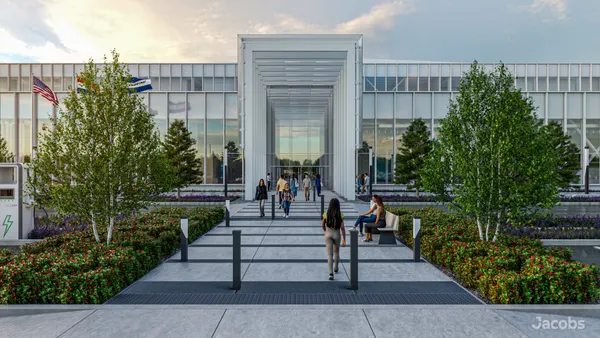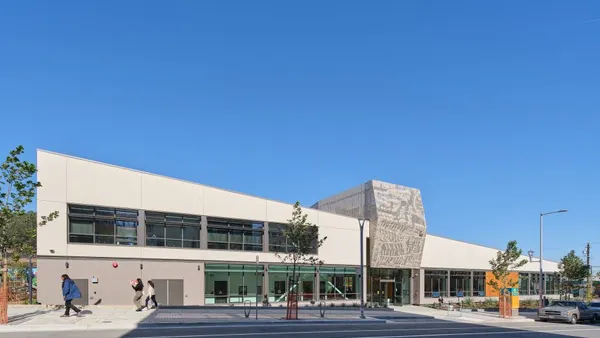Skanska USA has employed nontraditional project delivery methods for years, especially on health care jobs. The company has long been a fan of integrated project delivery, which has been used on projects ranging from the Palo Alto Medical Center in California to the renovation of the George Washington University Hospital ICU department in Washington, D.C.
Now, the Swedish-based company, the seventh largest in the U.S., is nearing completion on its biggest North American IPD project to date, a 465,000-square-foot hospital in Mullica Hill, New Jersey.
When complete later this year, the five-story, 210-room Inspira Medical Center Mullica Hill will include operating rooms, an emergency department and imaging suites as well as administrative, dining and support services. The $356 million project also includes a new central utility plant that will provide electrical power, heating/hot water and chilled water to the new hospital.
Under IPD, the Skanska team is working collaboratively with Array Architects and Leach Wallace Associates. IPD, which brings the design, construction management and owners together in the same contract, is a highly collaborative approach designed to maximize project outcomes and increase efficiency, Skanska USA Vice President of Operations Rebecca Pizzi told Construction Dive.
Construction Dive talked with Pizzi about how the team's interconnected approach helped minimize challenges on the fast-paced, multilayered construction project.
CONSTRUCTION DIVE: Why did the project team decide to use an IPD approach?
PIZZI: Inspira Health understood the collaborative benefits of IPD early on and selected a project team that had experience working outside of a traditional delivery approach. By integrating people, systems, business structures and practices into a shared process, IPD can help reduce waste and maintain full transparency regarding costs and schedule, which was a priority for Inspira Health.
What challenges have you faced?
PIZZI: This was the first IPD project for Inspira Health and many of the members of the project team, so there was a learning curve in using this approach. Because success with IPD relies heavily on open communications and collaboration between all partners, we had to ensure everyone was aligned on project milestones and delivery expectations so the project wouldn’t be delayed.
We also faced issues on the site itself, with a ton of weather events last year, including an inordinate amount of rain.
The site selection was done late, after we were awarded the project and everything was set. The site that was selected was an old orchard, which meant that the soil required special handling, delaying the project's start and adding to site work costs.
In addition, local design requirements changed during the course of design by the township/county redevelopment plan, therefore creating design and scope modifications in order to get approval.
How has this delivery method helped to overcome issues?
PIZZI: The IPD team collectively developed a schedule based on milestones, often overlapping, to make the flow from design to construction as streamlined as possible. This collective schedule allowed design and construction to work hand-in-hand, enabling the team to address inefficiencies early on and design only what was needed to accommodate the work-in-place schedule.
The intensive focus on design efficiency kept the team on schedule and eliminated delays by avoiding unnecessary redesign or over design, two common pitfalls on major developments. The team used Last Planner production planning software to help ensure that the project schedule was maintained and met in real time.
In addition, IPD especially guided the team to early coordination with trade subcontractors and extensive use of prefabrication, so there were no unnecessary delays with subcontractors, despite external factors such as weather events. To ensure timely decision making, there was ongoing education, onboarding and facilitation to ensure everyone involved understood what it meant to be on an IPD project, as well as the behaviors and attitudes required to make it a success.
Without the IPD approach guiding the team to work collaboratively as a single unit, the project may have fallen off track. The model encourages the entire team to contribute to pro and con discussions about a task, which means issues around cost and schedule can be solved in real time.
To date, all major construction milestones have been achieved within the established target value and the project is slated for delivery in November.
Now that the facility is nearly open, what were a few lessons learned from the project?
PIZZI: Some lessons we have learned from the process include:
- Communication and transparency are the keys to success on an IPD project. Frequent connectivity and a willingness to collaborate as a team are essential using this approach.
- The IPD work culture must be established early. IPD is built on shared risk and reward, so determining those parameters early in the process is essential for success. The team must develop a plan that is mutually agreed upon and beneficial for all parties.
- Staffing for the project needs to focus on people who are comfortable and capable in a transparent and team-centric environment. In this context, having existing positive relationships with owners, designers and subcontractors work well in IPD because trust and working style have already been established.













